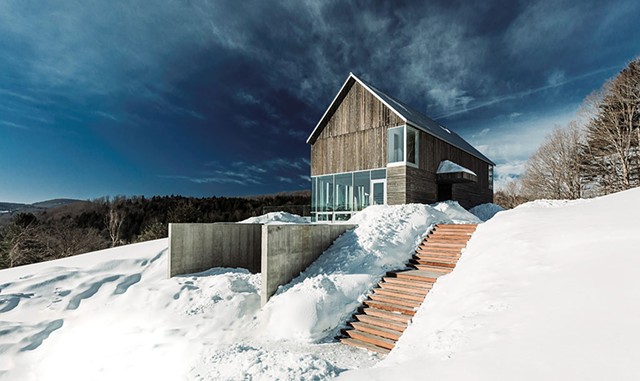
- Courtesy Of Birdseye
- Bank Barn in Woodstock was built into a bank to provide ground-level access to two different stories.
To reach Bank Barn, a house built just outside of Woodstock in 2019, you ascend a steep road leading to a long dirt driveway that curves up through a field. The Green Mountains soon appear off to the right, while above, on the left, the house comes into sight. Its long, boxy, gabled form looks not quite of this world, floating as it does on a first story that is end-to-end glass.
It's no wonder architect Brian Mac and his team at Richmond-based Birdseye felt compelled to give their creation a name. The traditional structure, a staple of Vermont barn types, is built into a bank to provide ground-level access to two different stories. In Birdseye's design, access to the basement level is through a carport whose exposed concrete walls cut into the bank on the narrow, gabled end of the house. Pedestrian entry to the house is at the main floor on the uphill side, which orients those entering toward the south-facing glass curtain wall.
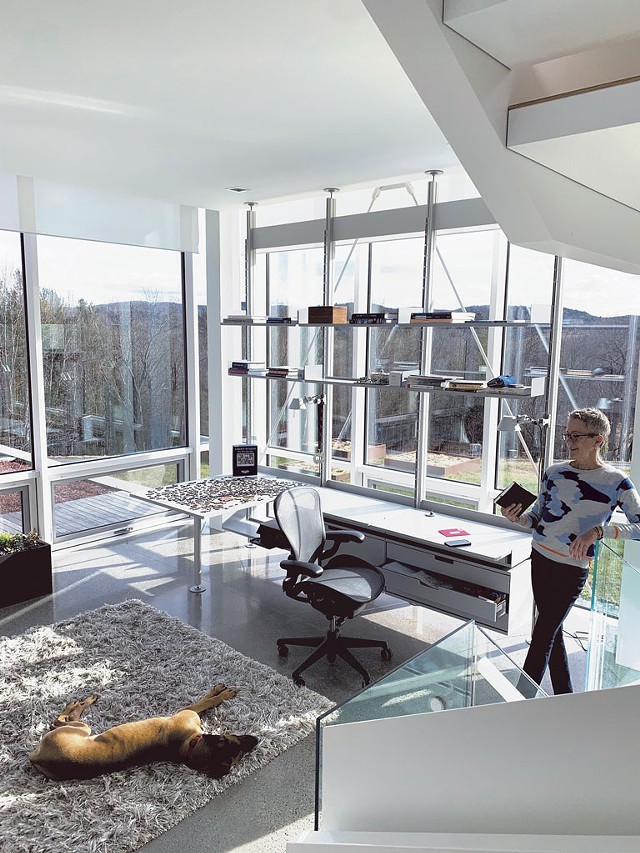
- Amy Lilly
- Lana Reuss in the office area
Owners Marc and Lana Reuss, along with their 6-month-old Rhodesian ridgeback named Red, warmly welcomed Nest into this haven of sunlight. The couple are solicitous and unfussy, and their house reflects that vibe. The entire main floor is one sweeping room, punctuated by a massive yet airy four-sided freestanding staircase that brings daylight down to the basement level. Not only is the south side of the house glass, capturing the mountains in one long vista, the east and west sides are, too.
From the kitchen, the view out the west curtain wall is both intimate and grand. The interior concrete floor extends seamlessly outside to an ipe wood deck with a built-in hot tub and, a few shallow steps down, a concrete deck with a fire pit and chairs. No railings obscure the views of fields, woods and mountains.
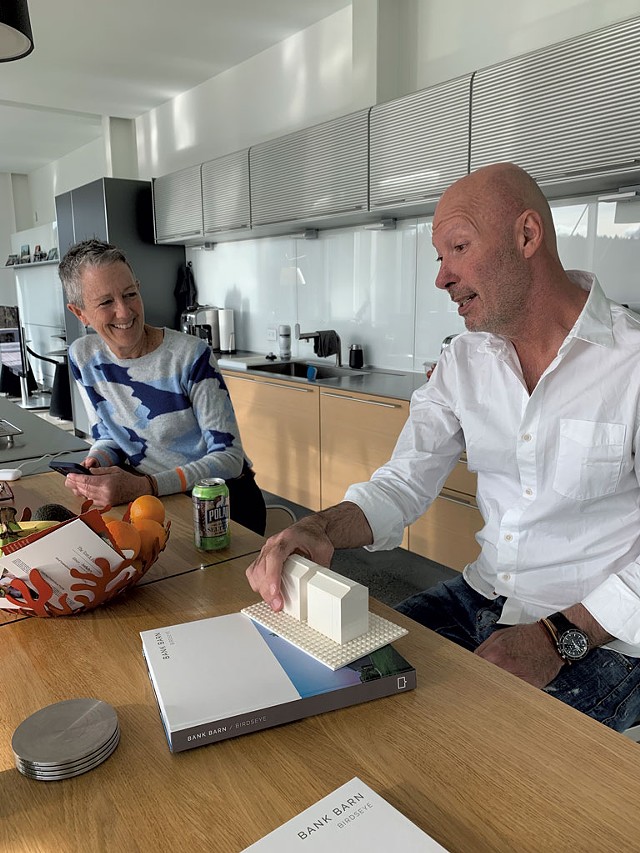
- Amy Lilly
- Lana and Marc Reuss, with a Lego model Marc made of the house during the design phase with Birdseye
The Reusses are unusual among owners of Birdseye houses. Mac and his team design such distinctive, luxe abodes — including the Mural House in Burlington, which won an award from the Vermont chapter of the American Institute of Architects last year — that their owners usually prefer to stay out of the spotlight. But the Reusses are devoted fans of the architect and his firm, and they enthusiastically agreed to a tour.
"They have an amazing amount of integrity that carries through to every employee," Marc declared of Birdseye. "Getting to know those guys, both personally and professionally, they're just super decent people."
Lana qualified that, adding, "You'll pay a lot more than you intended to. Within a month, we were 40 percent over budget. But you'll never question their integrity."
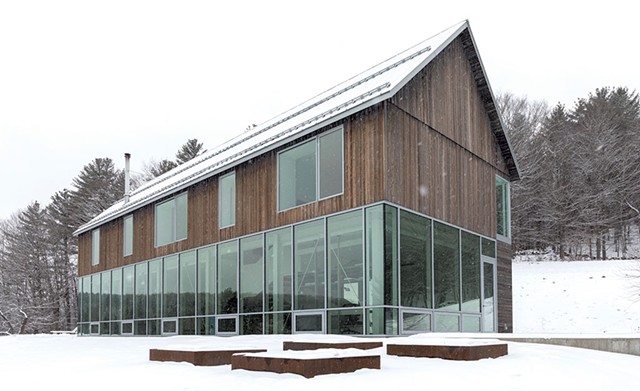
- Tom Mcneill
- The south side of Bank Barn
Marc, a retired human resources executive for pharmaceutical giant Novartis, and Lana, a former teacher, were at the end of a long stay in Europe — five years in Munich, three in London — when they decided to repatriate for Marc's retirement. One of their twin daughters had attended Middlebury College; during visits, the couple had fallen in love with Vermont, and Woodstock in particular. While a real estate agent scouted locales, landing them the 60-acre plot, they searched for Vermont architects online and found Birdseye.
Back in the United States, the couple first met with Mac over beers at Long Trail Brewing in Bridgewater Corners.
"They were beautiful people and just really fun and super interested in doing something unique," Mac recalled of the meeting.
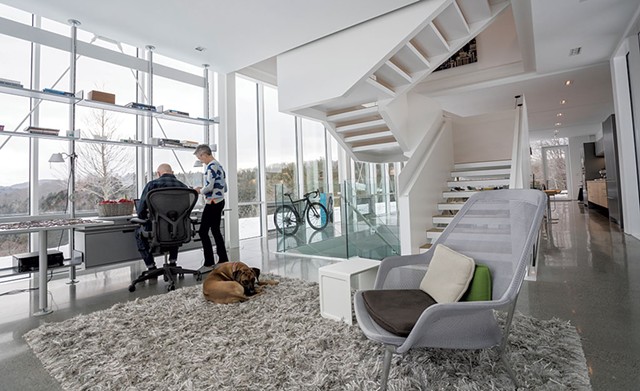
- Tom Mcneill
- The view from the main floor
Marc, who has a deep interest in architecture and a detailed knowledge of European-designed décor, brought along a model of the house he had in mind, which he had constructed from white Legos. He took it out during Nest's tour: The form is slightly more industrial than the house Mac created.
Birdseye consists of a 25-year-old architectural practice and a 40-year-old construction company specializing in detailed craftsmanship. Its approach honors Vermont's design-build tradition. The architects do two to three projects a year, but not all are built by the construction arm; the Reusses chose Birdseye Construction from three bids.
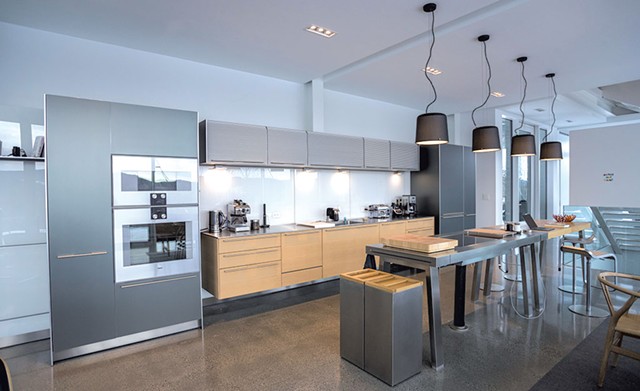
- Tom Mcneill
- The kitchen
Like Bank Barn, several of Mac's other home designs echo the agricultural structures common in their rural settings. These include Woodshed in Pomfret, clad in repurposed wood from snow fences and horse corrals; and Lathhouse in the Hamptons, whose exterior imitates lath, the narrow bands of wood spaced slightly apart for ventilation in corn cribs and drying barns.
Bank Barn, honored by both the Vermont and the New England chapters of the American Institute of Architects, has an additional accolade: its own book. The 200-page monograph was recently published by Oscar Riera Ojeda as part of its international Masterpiece Series — putting Birdseye in the company of California-based Faulkner Architects and Alberto Campo Baeza in Madrid, among a dozen select firms.
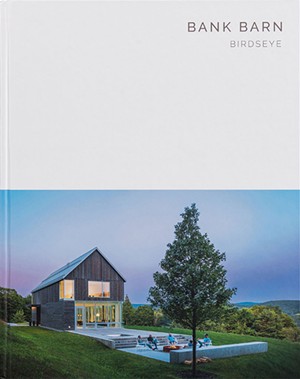
- Courtesy
- Bank Barn: Birdseye, Oscar Riera Ojeda Publishers, 200 pages, $49.99.
Bank Barn: Birdseye includes a foreword by Phish bass guitarist Mike Gordon (Mac designed Gordon's Lake Champlain home, as well as longtime Phish manager John Paluska's Burlington house); an intro by Tim McKeough, a design writer for the New York Times; and an interview with Mac conducted by Vladimir Belogolovsky, a prolific design writer and architectural exhibition curator who trained as an architect. Oh, and gobs of gorgeous photos.
In the book interview and on the phone with Nest, Mac described his aesthetic as a desire to "edit out" as much as possible, leaving just the bare minimum forms of a building. Instead of gutters, the roof has an extended overhang and gravel-covered French drains beneath. Vents from the kitchen and dryer are custom-made and integrated into the exterior cedar siding. A hallway pocket door on the second floor is exactly the height of the nine-foot ceiling.
Mac, a Midwesterner who earned his architecture degree at the University of Detroit, said he was primarily influenced by his modernist professors and the "accessible" architecture of Frank Lloyd Wright's houses.
"He was my go-to architect," Mac said. The father of modernism's influence is clear in Bank Barn's sensitivity to nature and the blurring of outside and in by details such as the continuous kitchen floor and ipe deck separated only by glass, and the second-story corner-wrapped windows. Both are features of Wright's Fallingwater in Pennsylvania.
Marc's own aesthetic seems well matched to the architect's. He sourced all of the furniture, lighting and plumbing. The sleek, industrial kitchen, manufactured in Germany by Bulthaup, complements the Bulthaup solid-oak dining table, black hanging lamps by Vipp and Eames lounge chairs. Upstairs, each sparely furnished bedroom has its own bath with equally sleek fixtures by Vipp.
The white walls have been left undecorated but for two large-format photographs — of New York City and Red's great-uncle — and, on the basement level, a wall-hung wine rack and sparsely filled display shelf.
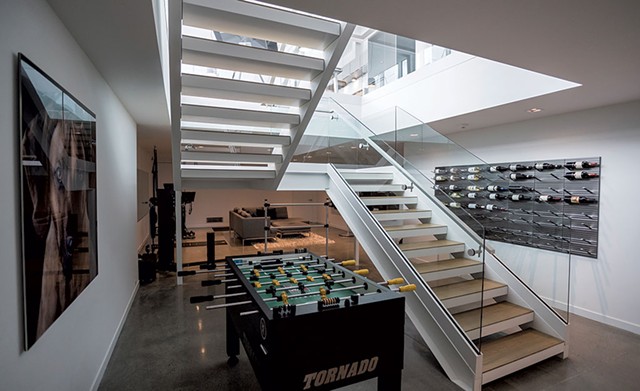
- Tom Mcneill
- The view from the basement level
A Rais woodstove in the living area provides only a fraction of the heat for the 4,500-square-foot home. Bank Barn has a geothermal system that powers the radiant floors on all three levels. Meanwhile, a 15-kilowatt array of three ground-mounted solar panels — Mac said he didn't want to mar the roof's aesthetic — generate the house's only source of energy: electricity.
Though carefully modeled for energy use by New York City environmental consultants Atelier Ten, the house isn't as close to net-zero as intended. "We still use plenty of electricity in the winter," said Lana.
Back on the main floor, Marc mentioned that the 16,000-pound steel staircase was dropped in by crane in late February, when the ground was frozen enough to support its weight. Its floating oak risers span banisters made of steel sheet or glass.
"Every angle on the stairs — you never get tired of it," Marc said. That goes for the whole of Bank Barn, he added: "It's a source of endless joy."
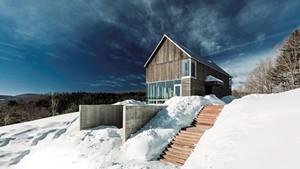









Comments
Comments are closed.
From 2014-2020, Seven Days allowed readers to comment on all stories posted on our website. While we've appreciated the suggestions and insights, right now Seven Days is prioritizing our core mission — producing high-quality, responsible local journalism — over moderating online debates between readers.
To criticize, correct or praise our reporting, please send us a letter to the editor or send us a tip. We’ll check it out and report the results.
Online comments may return when we have better tech tools for managing them. Thanks for reading.